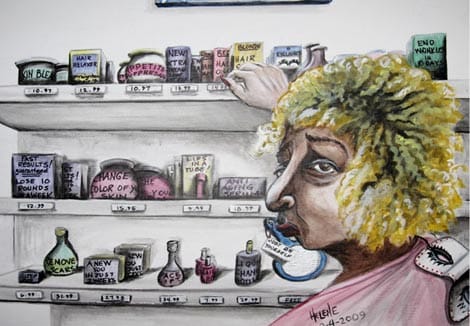by Eesha Pandit
Why care about women’s health in health care reform? I think it’s critical for reproductive justice advocates to also become health care advocates in today’s world, but the reasons why were best captured by the 19th century Swiss poet and philosopher Henri Frederic Amiel. He wrote: “In health there is freedom. Health is the first of all liberties.”
Reproductive justice advocates have a unique opportunity to bring together disparate social justice movements to forge a compelling case for health care reform that meets women’s needs.

This is a tall order. Health care is a matter of life and death, especially for our most marginalized communities. The U.S. health system is broken. It is hard to access, it is expensive to use, it is profit driven, it leaves vulnerable communities without a safety net. It will take quite a lot to get it where it needs to be, but without the voices of reproductive justice advocates, it will never fulfill its promise: to keep us healthy.
Adversaries Play With Women’s Health
When I heard President Obama’s call to action on healthcare in February 2009, I thought about what true health care reform would mean for the communities that I live in, work in and advocate for. The potential, of true reform, seemed limitless.
The discussion over health care began with five reform plans, each emerging from a relevant U.S. House or Senate committee that has jurisdiction over health care in some way. These will be drawn down into one bill from each house and then, ultimately, one bill from all of Congress that the president will either sign or veto. In this entire process of bill writing, there is only one health care service, deemed both safe and legal, that is being targeted for explicit exclusion in some of the bills. That is, of course, abortion.
Since this debate began, an onslaught of opposition to reform has emerged. Opponents have made a clear target out of women’s reproductive health care needs.
The National Association of Evangelicals (NAE) says, “Abortion is not health care. Any health care plan which includes coverage for elective abortion should be rejected. This includes abortion referral, payment for abortion, or the training of medical personnel for abortion practices.”
| What does it mean to be healthy? |
Furthermore, the NAE battle lines extend to any reproductive health care. It writes: “Persons who engage in behavior which adversely affects their health, such as smoking, drug and alcohol abuse, promiscuity and over-eating, should be responsible for the additional medical liability.”
Yet again, the politics of exclusion are masquerading as the ethic of personal responsibility. The behaviors noted by NAE are a means of differentiating between those communities that “deserve” health care and those that do not. This pattern has occurred before — in the “War on Drugs,” in “Welfare Reform,” and in countless other efforts to paint low income people, people of color and poor people as not deserving of social services through some fault of their own. It should not taint the effort for health care reform.
Health and Justice
What does it mean to be healthy? Why is it, as Amiel asserted, “the first liberty?”
A measureof health is often made by assessing physical needs. This is central and inexorable. But, as reproductive justice advocates know, it is more, as well.
A woman’s ability to control her body and its reproductive capacity is central to securing overall health. Access to abortion and contraception are the tip of a very large iceberg of needs.
Acknowledging a history of eugenics and population control, the reproductive justice approach aims to ensure that women have all the medical and social resources they need to have children, or not, as well as the right to control if, when and how they become mothers. This awareness, while including access to abortion and contraception, extends to other needs, as well:
1. Maternity care, including pre- and post-natal care and infertility treatment;
2. A range of birthing options including midwives, doulas and alternative care providers;
3. Mental health services;
4. Preventative care, including but not limited to, Pap smears, vaccinations (such as HPV), childbirth education and mammograms;
5. Services that are ethnically and culturally competent;
6. Care that is sensitive to people of all different genders and sexual orientations and addresses their unique concerns;
7. Health care services that are economically and physically accessible to women and their families.
The reproductive justice movement thinks more broadly about the political, cultural, economic, racial, institutional and environmental factors that pertain to bodily health. A reproductive justice-based approach considers not only what illness a woman might have, but also the social factors (environmental toxins, access to preventative care, community health education, and so on) that make her more or less prone to getting sick and more or less able to afford treatment.
This comprehensive approach changes the meaning of “health” rather dramatically. “Health” no longer simply refers to whether or not a person is sick or whether or not a woman can get reproductive health care. Instead, it diagnoses the factors that contribute to, or detract from, overall wellbeing, not merely for a single woman, but also for her family and the community in which she lives. This is what Amiel means, I believe, when he says that in health there is freedom.

Reaching Out to Social Justice Partners
A vision of women’s health that utilizes the reproductive justice framework incorporates the leadership of women of color, poor women and young women who can determine their own needs and decipher a course of action based on their lived experiences.
Strategic considerations mean advocating for health care that is not exclusionary on the basis of race, gender, age, sexuality, ability or citizenship. Expanding the current healthcare systems will not be sufficient — we must acknowledge and actively address the disparities that exist, mobilizing people from allied social justice and human rights organizations to think of “health” as expansively as possible. Finally, we must integrate broad-based grassroots organizing into advocacy and use it to inform our legal strategies.
The past eight years have been tough, and reproductive justice advocates have been stemming the tide of anti-women legislation, holding back the onslaught of regressive policies.
Looking ahead requires a shift in perspective, one that I am just beginning to make myself. It is a shift from defense to offense, from protection to progress.
I consider that we have an opportunity to be visionaries. To actually make changes in the service of our vision. To hold our legislators accountable to our needs. To secure health care as the first of all liberties.
Eesha Pandit is currently Director of Advocacy at The MergerWatch Project in New York. She is active in MergerWatch’s work with Raising Women’s Voices, a national initiative working to make sure women’s voices are heard in the health reform debate. She has been a regular contributor to RH Reality Check and previously served as Associate Director of Programs at the Civil Liberties and Public Policy Program. She has also worked with the Carr Center for Human Rights Policy at Harvard University and Amnesty International USA’s Women’s Rights Program. She is a graduate of Mount Holyoke College and the University of Chicago.
Also see “Stimulating Social Change, Then and Now” by Suzanne Pharr in this edition of On The Issues Magazine.
See “To Stop Gender Violence, Start Changing the Tune” by Andrea Smith in this edition of On The Issues Magazine.
